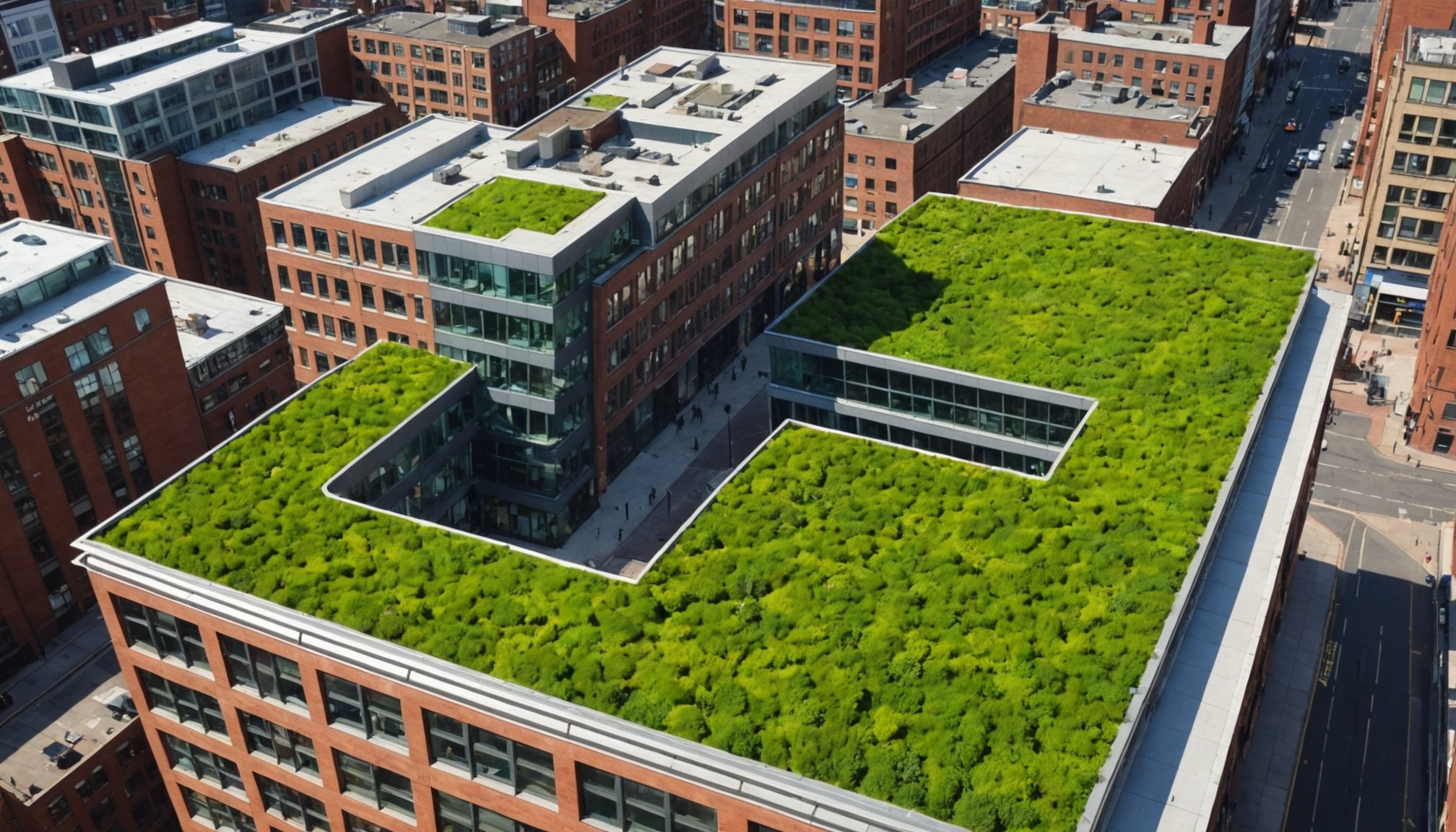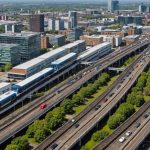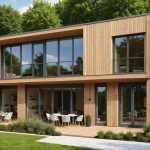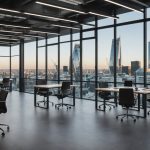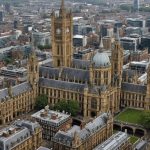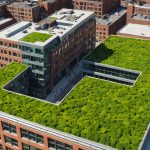Overview of Green Roofs
Green roofs are a compelling element in urban planning, offering multifaceted benefits for cities striving for sustainability. At their core, these roofs are vegetated covers installed atop conventional building structures. They comprise several layers including a waterproof membrane, drainage material, a growing medium, and a variety of plants. This thoughtful design supports plant growth while protecting the building beneath.
Traditionally, rooftops are underutilized spaces in urban settings. With green roofs, however, these spaces transform into functional areas contributing significantly to urban sustainability. Historically, the concept of green roofs isn’t new. Ancient civilizations utilized basic forms of green roofs, but their incorporation into modern urban planning gained momentum in the late 20th century, with European cities leading the charge.
Also read : Strategic Guide: Selecting the Ideal Site for Your New Office Development in Post-Brexit London
Today, cities around the world embrace green roofs not only for their aesthetic appeal but also for their broader environmental benefits. These include improved air quality, enhanced biodiversity, and stormwater management beyond just heat mitigation. Plants absorb pollutants, provide habitats for urban flora and fauna, and manage rainwater through natural filtration. Ultimately, green roofs exemplify a seamless blend of nature and architecture, paving the path for more sustainable urban landscapes.
Effectiveness of Green Roofs in Urban Heat Mitigation
In tackling the challenge of urban heat islands, green roofs serve as an innovative solution. By absorbing sunlight and providing insulation, these vegetated rooftops bring noteworthy temperature reduction. They function by evaporative cooling, which helps to offset heat that typically accumulates in dense urban areas.
Also to read : Assessing the Future Potential of Coastal Property Investments in the UK: A Comprehensive Guide
Statistical data from Birmingham illustrates the impact of green roofs on temperature reduction. Studies indicate an average temperature decline of up to 5°C in areas with significant green infrastructure. This utility is not unique to Birmingham. Similar initiatives are observed in cities like Copenhagen and Toronto, where green roofs play a pivotal role in urban climate strategy.
In comparative analysis, cities embracing green infrastructure experience notable differences in the mitigation of urban heat islands. The city-specific adaptations, like the choice of plant species or the density of installed green roofs, heavily influence the degree of environmental cooling achieved.
Ultimately, adopting green roofs as part of urban heat island strategies transcends aesthetic benefits. This approach forms a critical part of sustainable urban planning, promising both ecological and human-centric advantages. The collaborative implementation across cities signals a positive shift towards more robust and adaptable urban environments.
Case Studies of Green Roofs in Birmingham
In Birmingham, several key projects have embraced the innovation of green roofs, showcasing local excellence in urban planning. One prominent example is the Library of Birmingham, which features a terrace garden enhancing biodiversity and providing a relaxing space for visitors. This project highlights the potential for green spaces in urban settings while improving air quality and reducing urban heat islands.
Other noteworthy Birmingham case studies include the green roof atop the Bullring Shopping Centre, which demonstrates the feasibility of integrating eco-friendly designs into commercial spaces. This project faced challenges, such as maintaining consistent vegetation and managing the initial costs; however, it successfully reduced stormwater runoff and energy consumption.
Success factors in these local examples typically encompass strong collaboration between urban planning teams and environmental experts. Furthermore, innovative design solutions catered to Birmingham’s specific climate and architectural constraints, ensuring practical and aesthetically pleasing outcomes.
Community impact has been significant, with reports of enhanced wellbeing among residents and increased property values. Environmentally, these projects contribute to urban biodiversity and improved air quality. Understanding and addressing the unique challenges faced in these case studies can provide valuable insights for future green roofing initiatives in other cities.
Comparative Analysis with Other Cities
Green roof initiatives have gained prominence across global cities as a sustainable solution to urban challenges. In London, expansive green roof programs contribute significantly to urban heat management, offering cooler environments and enhancing biodiversity. New York City, similarly, has integrated green roofs into its urban landscape, tying them to energy efficiency and stormwater management.
When comparing these city initiatives, one notes key differences in implementation strategies. For instance, London’s emphasis is on regulatory frameworks that incentivise green roofs, whereas New York focuses on financial incentives and grants. Both approaches reflect diverse policy landscapes and resource availability, highlighting adaptable frameworks for Birmingham.
Birmingham can glean critical lessons from these successful green roof programs. Prioritising community engagement and robust partnerships has proven effective in fostering widespread acceptance and support. Moreover, tailoring strategies that address specific local needs, like mitigating urban heat or enhancing air quality, aligns resources with desired outcomes.
Best practices also indicate that measurable goals and continuous evaluation are crucial. By applying these insights, Birmingham can craft its green roof strategy to maximise effectiveness while ensuring alignment with broader environmental and urban development goals.
Recommendations for Urban Planning
Urban planning is pivotal in creating sustainable cities. Policy frameworks are crucial for encouraging green roofs, which help combat urban heat, manage stormwater, and improve air quality. To spur green roof adoption, urban planners should develop incentives like tax breaks or grants for building owners. These strategies not only financially reward green roof implementation but also promote broader environmental benefits.
Integration with existing urban infrastructure is essential. Green roofs can be seamlessly incorporated into both new and retrofit projects, aligning with urban development goals while enhancing biodiversity. Ensuring compatibility with existing buildings involves evaluating structural integrity and selecting appropriate materials to support plant growth without compromising safety.
Stakeholder engagement and community involvement are vital for successful implementation. Engaging local communities through workshops and consultations helps raise awareness about the benefits, such as energy savings and urban beautification, encouraging broader acceptance and enthusiasm. Collaboration among city planners, environmental experts, and residents builds trust and fosters a collective vision for greener cities.
By aligning urban planning policies with ecological goals, cities can transition towards sustainable development models. Embracing these recommendations ensures that urban spaces evolve to meet environmental challenges while enhancing urban livability for future generations. In essence, urban planning should holistically integrate green innovations for long-term urban resilience.
Future Research Directions
Urban areas like Birmingham demand ongoing attention to address challenges such as urban heat islands and the role of green infrastructure. Recent studies have made strides, yet crucial gaps remain in our understanding. These research priorities focus extensively on developing robust systems to predict and mitigate rising temperatures in urban settings.
Identifying gaps in current research is paramount. There is a need for studies with stronger evidence that captures the multifactorial dimensions of urban heat islands. Moreover, the development of a comprehensive set of metrics for future studies is required. These metrics aid in accurately evaluating air temperature variations and surface reflectivity, which, in turn, inform better city planning.
Ongoing monitoring and evaluation systems play a critical role in adaptation strategies. Without them, it becomes difficult to measure the effectiveness of interventions like increasing green spaces. Establishing systems for regular data collection ensures the implementations are data-driven and sustainable.
Exploration into more resilient forms of green infrastructure also stands as a primary research area. This includes developing plants resistant to changing climates and offering better thermal benefits. Prioritising these efforts can lead to healthier urban living and a reduction in the negative impacts of urban heat islands.

